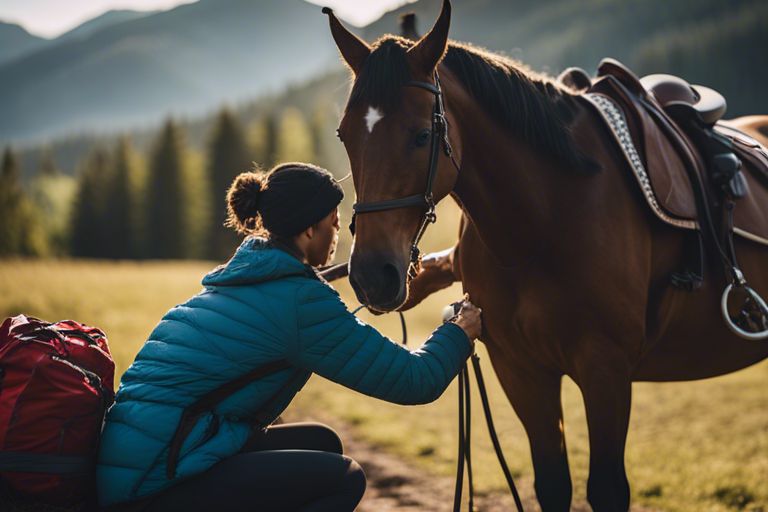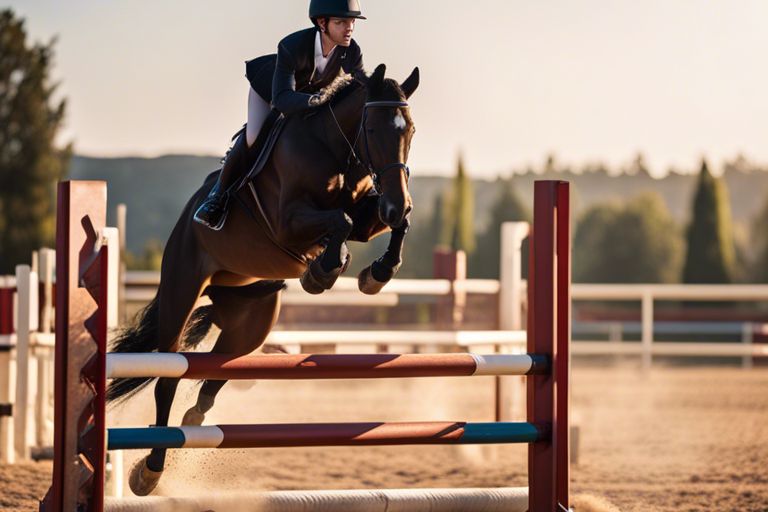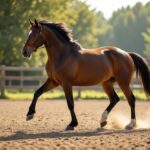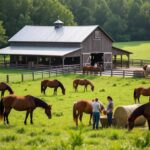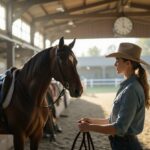Tips for beginners venturing into the world of horseback riding can make all the difference in ensuring a safe and enjoyable experience. As you initiate on this new adventure, familiarize yourself with techniques for mounting, proper posture, and communication with your horse. Understanding these basics will not only help you build a strong foundation but also prevent common mistakes that could lead to accidents. With the right guidance and practice, you’ll soon be confidently navigating the trails on horseback.


Understanding Horseback Riding Types
A key aspect of horseback riding is understanding the different types of riding styles. Each riding style has its techniques, equipment, and attire. Here is a breakdown to help you navigate the various riding types:
| English Riding Styles | Western Riding Styles |
| Jumping | Trail Riding |
| Dressage | Reining |
| Eventing | Barrel Racing |
| Hunter | Western Pleasure |
| Equitation | Roping |
English Riding Styles
If you are interested in a more traditional riding style, English riding may be for you. This style emphasizes close contact between you and the horse, with a focus on precision and technique. English riding includes disciplines such as jumping, dressage, eventing, hunter, and equitation. Each discipline has its own set of skills and requirements, allowing you to choose one that suits your interests and goals.
Western Riding Styles
Western riding is known for its comfortable, relaxed approach to riding. Western riders often use a Western saddle, which is larger and provides more support than an English saddle. Popular Western riding disciplines include trail riding, reining, barrel racing, western pleasure, and roping. Any rider can find a Western discipline that appeals to them, whether it’s the thrill of speed in barrel racing or the skill of precision in reining.
Other Disciplines and Styles
Now, let’s explore some other disciplines and styles that you may encounter in the world of horseback riding. These include endurance riding, polo, vaulting, and therapeutic riding programs. Each discipline offers a unique experience and challenges, allowing you to broaden your horizons and skills as a rider.
Horseback riding opens up a world of possibilities, with various riding types to suit every rider’s preferences. Whether you prefer the elegance of English riding, the laid-back vibe of Western riding, or the excitement of other disciplines and styles, there is something for everyone in the equestrian world. So, explore the different riding types, find what resonates with you, and enjoy the journey of becoming a skilled and versatile horseback rider.
Essential Tips for Beginner Riders
If you are new to horseback riding, there are a few key tips and techniques that will help you feel more confident and comfortable in the saddle. Here are some necessary tips to keep in mind as you start your riding journey:
Pre-Ride Preparation
Any time you ride, make sure to check your equipment and tack for proper fit and safety. Ensure your helmet is secured and fits correctly. Additionally, spend some time grooming and bonding with your horse before you ride to establish rapport.
After checking your equipment and grooming your horse, always warm up before starting your ride to prepare both yourself and your horse for the workout ahead.
Mounting and Dismounting Techniques
While mounting and dismounting may seem simple, it is important to learn the correct techniques to ensure your safety and comfort. Ask your instructor to show you the proper way to mount and dismount, using appropriate mounting blocks if needed.
After you mount, adjust your stirrups to the correct length to maintain good balance and security in the saddle throughout your ride.
Balance and Posture in the Saddle
Techniques for maintaining balance and proper posture in the saddle are crucial for effective riding. Focus on keeping your heels down, shoulders back, and sitting tall in the saddle. Remember to align your body with your horse’s movements to stay centered and stable.
Another important aspect of balance is engaging your core muscles to support your posture and absorb the motion of the horse beneath you. Practice exercises off the horse to strengthen your core and improve your riding stability.
Communicating with Your Horse
Mounting your horse is not just about getting on – it’s also an opportunity to establish a connection and communicate with your horse. Pay attention to your horse’s body language and responsiveness to your cues to build trust and cooperation in your partnership.
For instance, use subtle aids like leg pressure and rein contact to convey your intentions to your horse. Developing clear and effective communication with your horse will enhance your riding experience and overall performance.

A Step-by-Step Guide to Horseback Riding
Despite being a beginner, horseback riding can be a fun and rewarding experience if you approach it with the right mindset and preparation. Below is a step-by-step guide to help you navigate through the basics of horseback riding.
| Getting Familiar with the Horse’s Body Language | Mastering the Basic Riding Positions |
| With time, you will learn to interpret your horse’s body language, which is crucial for effective communication and building trust. Understanding signs of agitation, relaxation, and attentiveness will help you better connect with your horse. | Clearly understanding and mastering the basic riding positions such as the correct posture, balance, and grip will make all the difference in your riding experience. This foundation will not only keep you safe but also ensure a smoother ride. |
Getting Familiar with the Horse’s Body Language
With time, you will learn to interpret your horse’s body language, which is crucial for effective communication and building trust. Understanding signs of agitation, relaxation, and attentiveness will help you better connect with your horse. **It is important to pay attention to your horse’s ears, eyes, and overall body posture as they can tell you a lot about how the horse is feeling and what it might do next.** Building a strong bond with your horse through understanding and responding to its body language will make your riding experience more enjoyable and safe.
Mastering the Basic Riding Positions
Clearly understanding and mastering the basic riding positions such as the correct posture, balance, and grip will make all the difference in your riding experience. This foundation will not only keep you safe but also ensure a smoother ride. **Maintaining a straight back, keeping your heels down, and looking ahead are key elements of a good riding position that will help you stay in control and communicate effectively with your horse.** Plus, having a strong and balanced position will give you the stability needed to handle different gaits and maneuvers with ease.
Learning to Walk, Trot, and Canter
Some of the first riding skills you will learn are how to walk, trot, and canter with your horse. These are the three basic gaits that every rider should be comfortable with. **Walking is the slowest and most stable gait, trotting is a bouncy two-beat gait, and cantering is a three-beat gait that is faster and smoother than trotting.** To master these gaits, you will need to focus on your balance, rhythm, and communication with the horse to move together seamlessly.
Turning and Stopping Techniques
To effectively control your horse, you need to learn turning and stopping techniques that are important for steering and halting. While **directing your horse, remember to use your reins and body weight to indicate where you want to go.** Stopping your horse requires a combination of using your reins, seat, and voice commands to slow down and eventually come to a halt. **Practicing these techniques regularly will help you establish a strong connection with your horse and improve your overall riding skills.**
Important Factors to Consider When Horseback Riding
Your safety and enjoyment when horseback riding depend on various factors that you should consider before getting on a horse. Understanding these factors will help you have a successful and fulfilling riding experience. Here are some key factors to keep in mind:
Horse Selection and Temperament
Clearly, the choice of horse plays a significant role in your riding experience. Consider the horse’s size, breed, training level, and temperament. Match the horse’s characteristics with your skill level and riding goals to ensure compatibility. It is crucial to form a bond with the horse and feel comfortable and safe while riding. Perceiving the horse’s temperament and behavior will help you build a trusting relationship.
Rider Fitness and Physical Ability
Temperamentulae fitness and physical ability are important when it comes to horseback riding. Being in good physical shape will help you maintain balance, coordination, and control while riding. Rider Fitness also impacts your endurance and ability to respond quickly to various situations that may arise while on horseback.
Safety Equipment and Precautions
On every ride, you must prioritize safety by wearing the necessary safety equipment and taking precautions. It is crucial to wear a properly fitted helmet, suitable footwear, and any other protective gear recommended for horseback riding. Ensure that your equipment is in good condition and that you know how to use it correctly to prevent accidents.
Environmental Factors and Trail Riding
Physical environmental factors such as terrain, weather, and trail conditions can significantly impact your riding experience. Being aware of these factors will help you prepare adequately and make informed decisions while on the trail. Recognizing the signs of fatigue, dehydration, or changing weather conditions can help you stay safe and enjoy your ride to the fullest.
Trail riding allows you to explore nature and enjoy the great outdoors on horseback. It can be a rewarding experience, but it is important to consider the environmental factors that may affect your ride. Recognizing the natural beauty around you, respecting wildlife and habitats, and following trail etiquette will enhance your trail riding experience.
Horse Experience and Performance
When selecting a horse for your ride, pay attention to its experience and performance level. Horse experience with different trails and terrains can influence how confident they are on the trail. Strong>It is important to match your riding skills with the horse’s experience to ensure a safe and enjoyable ride. Additionally, consider the horse’s performance in terms of gait, responsiveness to cues, and overall behavior to have a smooth and enjoyable ride.
Pros and Cons of Horseback Riding
All Pros and Cons of horseback riding can help you make an informed decision before taking up this activity. Here is a breakdown in the table below:
| Pros | Cons |
| Physical exercise | Potential risk of falls |
| Mental relaxation | Injuries from handling horses |
| Connection with nature | Time-consuming |
| Bonding with animals | Cost of equipment and maintenance |
| Increased confidence | Commitment to regular training |
Physical and Mental Health Benefits
You can benefit from horseback riding both physically and mentally. The physical activity of riding a horse helps improve your balance, coordination, and strength. Additionally, spending time with these majestic animals can have a calming effect on your mind, reducing stress and anxiety levels.
Social and Recreational Aspects
Now, engaging in horseback riding is not only a solitary activity. It can be a great way to socialize and meet like-minded individuals who share your passion for horses. Riding in groups or taking lessons with others can create a sense of community and camaraderie among riders.
Plus, horseback riding provides a recreational escape from the hustle and bustle of daily life. Whether you ride for pleasure or competition, being in the outdoors and connecting with these beautiful animals can bring a sense of joy and fulfillment to your life.
Potential Risks and Injuries
To fully enjoy horseback riding, it is crucial to be aware of the potential risks and injuries involved. While riding, there is always a risk of falling off the horse, which can lead to bruises, sprains, or more severe injuries. Additionally, handling horses, especially if not done correctly, can result in accidental bites or kicks.
Risks are inherent in any physical activity, and horseback riding is no exception. It is crucial to take necessary precautions, such as wearing appropriate safety gear and receiving proper training, to reduce the likelihood of accidents and injuries while riding.

Advanced Techniques for Improving Your Ride
For advanced riders looking to take their skills to the next level, there are several techniques you can focus on to refine your riding abilities. Whether you are interested in perfecting your balance and seat, improving communication with your horse, mastering transitions, or delving into advanced disciplines like jumping, these strategies can help you become a more skilled and confident rider.
Refining Your Balance and Seat
Any advanced rider knows that achieving a solid, balanced seat is vital for effective communication with your horse and for maintaining control during complex maneuvers. To refine your balance and seat, focus on:
- Exercises to Improve Balance
- Body Positioning Techniques
By actively working on your balance and seat through targeted exercises and conscious body positioning, you can become a more secure and effective rider.
Developing Effective Communication with Your Horse
Advanced riders understand the importance of clear and nuanced communication with their horses. Developing effective communication involves:
Advanced riders are well-versed in using subtle cues, body language, and rein aids to convey their intentions to their horses. By honing your communication skills and understanding your horse’s responses, you can work together more effectively as a team.
Mastering Transitions and Complex Maneuvers
Transitions and complex maneuvers are where advanced riders truly shine. Mastering these elements involves:
Transitions and complex maneuvers require precise timing, balance, and coordination between you and your horse. By practicing these elements consistently and focusing on your aids and cues, you can elevate your riding to a higher level.
Jumping and Other Advanced Disciplines
An advanced rider may choose to explore disciplines like jumping, dressage, or eventing to further challenge their skills. When delving into advanced disciplines, focus on:
- Jumping Techniques and Exercises
- Advanced Discipline-Specific Skills
Improving your abilities in advanced disciplines requires dedication, practice, and a willingness to push your limits. By working with a knowledgeable instructor and setting achievable goals, you can elevate your riding to new heights.
Final Words
Drawing together all the tips and techniques you’ve learned in this beginner’s guide to horseback riding, you are now equipped with the knowledge and skills needed to start your journey in the equestrian world. Remember to always prioritize safety, communicate effectively with your horse, and practice regularly to improve your riding abilities.
As you continue to refine your riding skills, don’t forget to enjoy the bond you are forming with your horse and the exhilarating feeling of freedom that comes with riding. Keep learning, exploring, and pushing yourself to new levels of horsemanship. With dedication and passion, you will become a confident and skilled horseback rider in no time.
FAQ
Q: What equipment do I need to start horseback riding?
A: To start horseback riding, you will need a properly fitted helmet, comfortable riding boots with a small heel, and appropriate riding attire such as long pants and gloves.
Q: How do I mount a horse properly?
A: To mount a horse, stand on the left side of the horse facing towards the rear, hold the reins in your left hand, and the saddle with your right hand. Place your left foot in the stirrup, and push yourself up and swing your right leg over the horse’s back.
Q: What are some basic riding techniques I should know as a beginner?
A: As a beginner, it’s important to learn how to sit tall in the saddle, use your legs to communicate with the horse, and maintain a light and steady contact with the reins. You should also practice basic riding skills such as walking, trotting, and steering your horse.
Q: How can I improve my balance and posture while riding?
A: To improve your balance and posture while riding, focus on keeping your shoulders back, sitting deep in the saddle, and engaging your core muscles. Practice exercises such as two-point position and posting trot to strengthen your balance and improve your posture.
Q: What safety tips should I keep in mind while horseback riding?
A: Always wear a properly fitted helmet, make sure your equipment is in good condition, and never ride alone. Always warm up your horse before riding, and be aware of your surroundings while on the trail. Always listen to your instructor and follow their guidance for a safe and enjoyable riding experience.


